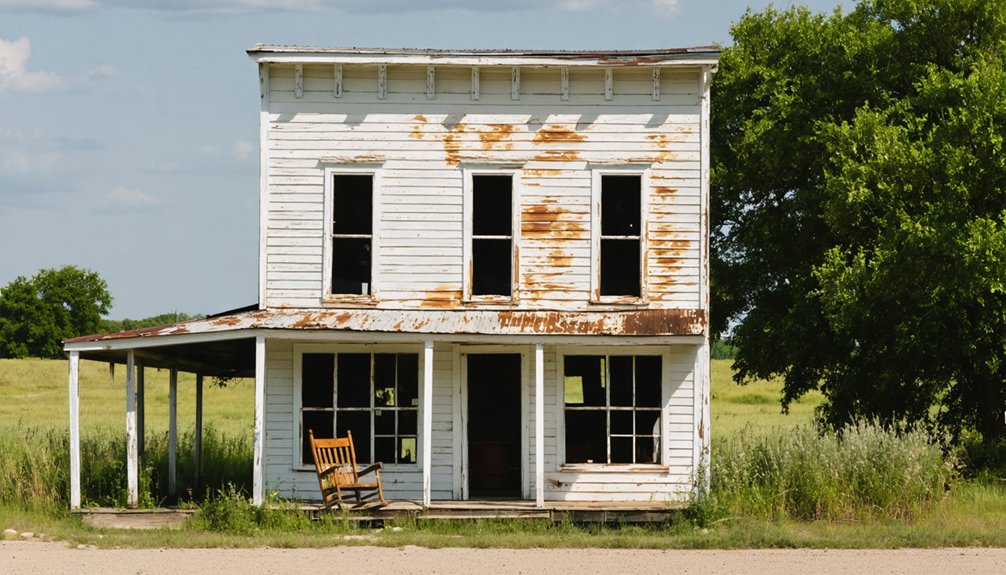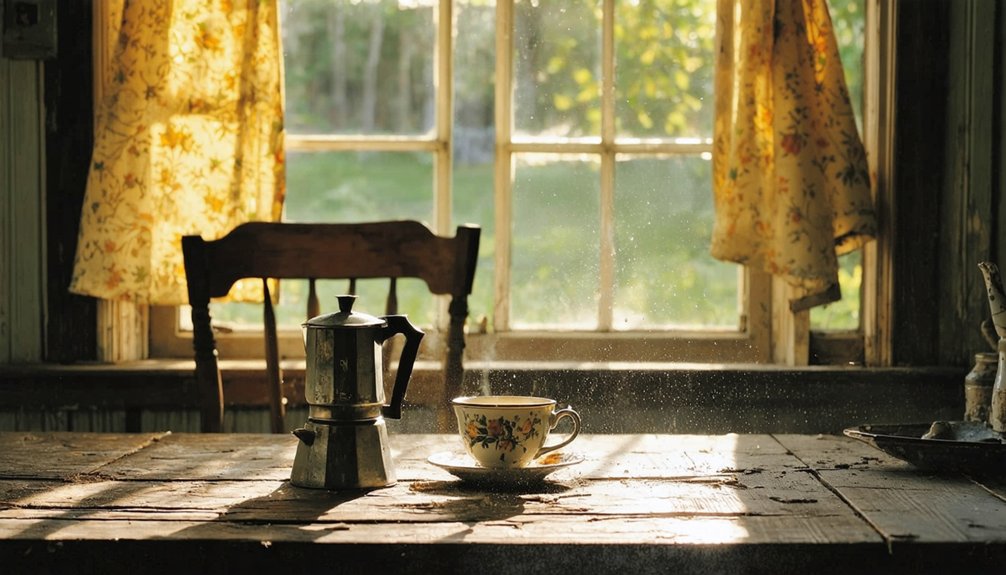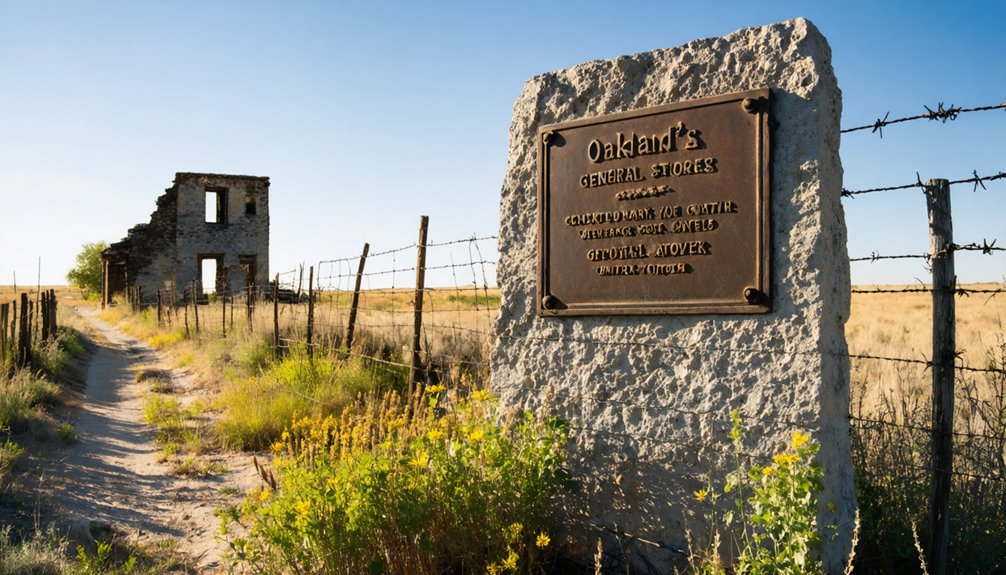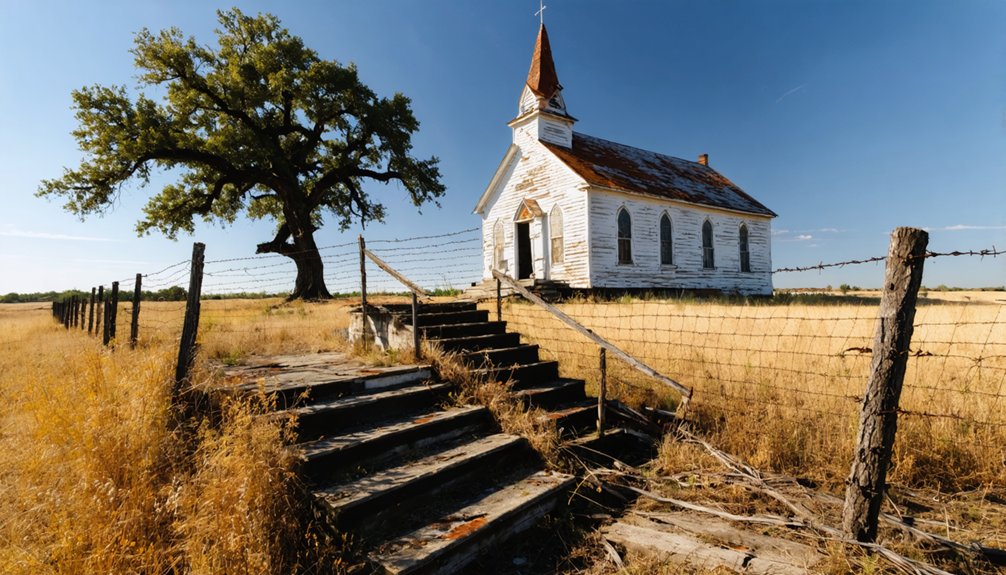You’ll find Oakland, Texas – originally called Prairie Point – about 150 miles southeast of Dallas. This former farming community peaked in 1892 with 150 residents before declining steadily. The town’s agricultural legacy centered on cotton production, with a gin, general store, and post office serving local farmers. Today, only scattered ruins and a 1988 historical marker on SH 7 remain to tell the story of this once-thriving frontier settlement.
Key Takeaways
- Oakland, Texas began as Prairie Point before being renamed in 1860, reaching its peak population of 150 residents in 1892.
- The town’s economy centered around cotton production, with a cotton gin serving as a crucial economic hub for local farmers.
- Essential services included a general store, post office, and schoolhouse, though the permanent population never exceeded thirty residents.
- Economic decline occurred when families relocated to larger towns for better employment, leaving the community unable to sustain itself.
- A historical marker was erected in 1988 on SH 7 to commemorate the ghost town’s significance in Texas history.
From Prairie Point to Oakland: The Story Behind the Name
While Prairie Point served as the town’s original name, a significant change occurred in 1860 when the post office relocated from Amasa Turner’s farm across the Navidad River to its new location.
This move marked a pivotal moment in the community’s identity, as Turner chose to rename the settlement “Oakland” in honor of David G. Burnet’s home.
The name significance extended beyond mere administrative changes, representing the town’s evolution from a frontier outpost to an established community.
The evolution from Prairie Point to Oakland symbolized more than a simple name change—it marked the community’s transformation into a thriving settlement.
You’ll find that this transformation coincided with the town’s growing prominence along the stagecoach route between Columbus and San Antonio.
The shift from Prairie Point to Oakland reflected the settlement’s maturation and its emerging role as an essential hub in Colorado County’s development. Under the direction of A. Schrimsher, the first postmaster of Oakland, the town began establishing itself as a crucial mail stop for the region.
The town was originally platted in 1856 by A.C. Hereford, a Mexican War veteran who had settled in the area during the early 1850s.
A Town Takes Shape: Early Settlement Years
During the 1830s, Oakland’s early settlement emerged as a scattered collection of homesteads rather than a formally platted township.
You’ll find that settlement patterns developed organically, with families establishing their homes beneath the area’s signature oak trees, focusing primarily on agricultural pursuits like cotton and corn farming.
The community’s dynamics were shaped by diverse influences, including Anglo colonists from Stephen F. Austin’s settlements and German immigrants who brought their own cultural traditions to the region.
While you wouldn’t have found formal infrastructure initially, the scattered nature of the settlement reflected the independent spirit of early Texas pioneers.
Much like the founding of Independence Baptist Church in nearby Independence, the establishment of religious institutions marked important milestones in community development.
It took several decades before you’d see the establishment of essential community structures like schools and churches, demonstrating the gradual evolution of this rural settlement into a more structured community. The area between the Trinity River and Crockett became home to pioneering families seeking new opportunities in the Texas frontier.
Peak Years and Community Life
As Oakland reached its zenith in 1892 with roughly 150 residents, you’d find a close-knit farming community where daily life centered on agricultural rhythms and social gatherings.
You could witness neighbors helping neighbors during planting and harvest seasons, strengthening bonds through shared labor and purpose.
In Oakland’s farm fields, shared toil among neighbors wove lasting community bonds that endured beyond the harvest season.
The town’s modest wooden structures housed essential services – a general store, post office, and schoolhouse – while churches served as crucial hubs for community gatherings and social cohesion.
You’d experience a lifestyle where seasonal fairs, religious celebrations, and school events brought everyone together.
Local commerce operated through a mix of cash and barter, with businesses providing the basic necessities for farming families.
Unlike the boom-and-bust cycles of nearby oil towns, Oakland maintained a steady, agriculture-based economy dependent on weather and crop yields. This stability contrasted sharply with places like Ranger’s oil boom, where populations could surge from hundreds to 30,000 in just a few years.
Similar to Bartlett’s agricultural heritage, the community thrived on cotton and grain production before the industry’s eventual decline.
Agricultural Heritage and Economic Activities
While exploring Oakland’s agricultural past, you’ll find that cotton production played a central role in the town’s economy through its local cotton gin operations.
The seasonal rhythms of cotton processing brought farmers from surrounding areas to Oakland’s gin, where their harvests were cleaned and baled for transport to larger markets.
Essential farm equipment and mills supported the community’s broader agricultural activities, though records of their specific operations remain limited in the historical documentation. The town’s agricultural decline mirrors modern challenges faced in areas like West Oakland, where food deserts have emerged in once-thriving farming communities. Many of these original farm families eventually relocated to larger towns in search of better employment opportunities.
Cotton Gin Operations
The cotton ginning operations in Oakland played a vital role in the region’s agricultural development during Texas’ cotton boom era. You’d find local farmers bringing their harvests to these multi-story facilities, where powerful machines separated cotton fibers from seeds around the clock during peak seasons. These operations were typically powered by gasoline engines that kept production moving efficiently. Similar to the historic Burton Cotton Gin Museum, these facilities preserved an important chapter in Texas cotton history.
The gins’ iron-toothed cylinders processed cotton into 500-700 pound bales, ready for transport to market.
The economic impacts of cotton ginning extended beyond mere processing. Gin owners became influential figures in Oakland’s commerce, often expanding into seed sales and labor management.
They’d operate their facilities for up to 24 hours daily during harvest season, providing essential employment for tenant farmers and laborers. This system helped transform raw cotton into a valuable commodity, strengthening Oakland’s position in Texas’ agricultural economy.
Farm Equipment and Mills
Working alongside Oakland’s cotton gins, diverse farming equipment and mills formed a robust agricultural infrastructure throughout the early 1900s.
You’d find horse-drawn plows and cultivators tilling the fertile soil, while mechanical threshers revolutionized grain processing. Local farming technology included crucial corn shellers, grinders, and manual seeders that kept small-scale operations productive and independent.
The town’s mills became crucial economic hubs where you could witness both water-powered and steam-powered milling techniques in action.
These operations processed locally grown wheat and corn, while lumber mills supported construction needs. You’ll appreciate how these facilities served dual roles as commercial enterprises and community gathering spots, where farmers exchanged goods and information.
This agricultural foundation kept Oakland’s economy thriving until broader mechanization and urban shifts altered the landscape forever.
Notable Buildings and Structures

As you explore Oakland’s remains, you’ll discover remnants of the historic commercial district where the town’s economic pulse once thrived.
The weathered foundations of the community’s cotton gin operations stand as proof of Oakland’s agricultural prominence in Texas’s early farming era.
While many structures have succumbed to time, traces of the town’s religious heritage remain visible through the scattered ruins of church sites that once served as spiritual and social anchors for Oakland’s residents.
Churches and Religious Sites
While Oakland itself retains few original structures, nearby ghost towns showcase remarkable religious architecture that tells the story of faith communities in early 20th-century Texas.
You’ll find evidence of diverse religious practices in sites like the Burning Bush Colony, where “Holy Jumpers” established their Methodist splinter community around 1900. Their distinctive worship style and self-published hymnals reflected a strong community identity separate from mainstream churches.
In nearby Bomarton, St. John’s Catholic Church stands as a symbol of local religious devotion. The 1936 brick structure features original stained glass windows, medallion work, and prayer alcoves.
Though its congregation has long dispersed, the building’s preserved interior elements offer you glimpses into the religious life that once flourished in these now-quiet Texas towns.
Cotton Gin Operations
During the early 1900s, Oakland’s cotton gin operations played a pivotal role in the region’s agricultural economy, though few physical remnants survive today. The local cotton production relied on advanced ginning techniques of the era, processing harvests from surrounding farms into marketable bales.
You’ll find that Oakland’s cotton gin, like many others across Texas, served as more than just a processing facility:
- It functioned as a community gathering point where farmers discussed crops and shared agricultural knowledge.
- The gin’s operations helped establish Oakland as a significant agricultural hub.
- Local farmers depended on the gin’s efficiency to maintain their economic livelihood.
This once-bustling facility represented the technological progress that transformed Texas agriculture, though today only scattered evidence remains of its former prominence in Oakland’s landscape.
Historic Commercial District
Since historical records about Oakland’s commercial district are limited, little definitive information exists about its notable buildings and structures. Without verified documentation, we can’t provide details about the historic architecture that once defined this Texas settlement’s business center.
The commercial evolution of Oakland remains unclear in available historical records.
While many Texas ghost towns have left behind ruins or documented evidence of their business districts, Oakland’s commercial footprint hasn’t been conclusively mapped or described in accessible archives.
You’ll find that tracing the development and decline of Oakland’s business sector presents significant challenges for historical researchers.
Until new records emerge or archaeological studies are conducted, the true nature of Oakland’s historic commercial district remains a mystery.
The People Who Called Oakland Home

Throughout Oakland’s modest history, the close-knit community never exceeded thirty residents, with records showing just twenty people by 1939 and twenty-six by 1974.
The scattered dwellings across the landscape fostered strong community bonds among the farming families who called Oakland home.
Though miles apart, Oakland’s farm families found unity in their scattered settlement, weaving unbreakable bonds through shared rural life.
You’d find the residents gathering regularly at three primary locations where social gatherings strengthened their rural ties:
- The local school, which saw its peak enrollment of twenty-one students in 1906
- Two churches that served as spiritual and social anchors for the community
- The single business establishment where neighbors would cross paths
These hardy folks made their living primarily through agriculture, creating a resilient community where everyone knew their neighbors despite the distance between homesteads.
Factors Leading to Decline
While Oakland’s tight-knit community had weathered many challenges, a perfect storm of economic and demographic pressures ultimately sealed the town’s fate.
Like many rural Texas settlements, Oakland’s lack of economic diversification left it vulnerable when the region’s traditional industries declined. You’ll find that the town’s inability to attract new businesses or adapt to changing market conditions accelerated its downward spiral.
Population migration dealt the final blow, as younger residents sought opportunities in larger metropolitan areas like Dallas-Fort Worth.
This exodus eroded Oakland’s tax base, leading to deteriorating public services and infrastructure. When severe weather events struck the isolated community, the town lacked the resources to rebuild effectively.
Without a sustainable economic foundation or the means to maintain essential services, Oakland’s transformation into a ghost town became inevitable.
Modern Day Remnants and Historical Markers

Today in Oakland, you’ll find few physical reminders of this once-vibrant rural settlement between the Trinity River and Crockett.
While scattered homes dot the landscape, the most prominent remnants today include the historical marker erected in 1988 on SH 7, located 6.6 miles west of Crockett near the Dickson Hopewell Road turnoff.
The historical significance of Oakland is preserved through:
- An aluminum marker detailing the community’s past, including its namesake oak trees
- Descendants of early settlers Wilson E. Hail and Z.S. Thompson who still call the area home
- The legacy of brief-lived institutions like the church, school, and cotton gin
Though Oakland never developed into a formally platted townsite, these remnants serve as evidence of the rural settlement’s role in late 19th and early 20th century Texas history.
Preserving Oakland’s Historical Legacy
Despite Oakland’s physical decline over the decades, dedicated preservation efforts have transformed this ghost town into a living historical archive.
You’ll find community engagement at the heart of Oakland’s conservation, with local historical societies and volunteer groups working tirelessly to maintain historic sites and prevent further degradation.
Multiple archival initiatives safeguard Oakland’s heritage through digitization projects, oral history recordings, and document preservation.
You can access these materials online, exploring maps, photographs, and personal narratives that bring the town’s past to life.
The Texas Historical Commission, alongside local preservation organizations, provides essential support through grants and expertise.
Together, they’re implementing structural stabilization plans, managing visitor access, and creating interpretive programs that guarantee Oakland’s story continues to educate and inspire future generations.
Frequently Asked Questions
Are There Any Documented Paranormal Activities or Ghost Stories From Oakland?
While you might yearn to discover ghost sightings in Oakland’s abandoned structures, there aren’t any officially documented haunted locations or paranormal activities in the historical record of this Texas ghost town.
What Happened to the Families Who Left Oakland During Its Decline?
You’ll find that families followed typical migration patterns, heading toward urban centers for better opportunities. Their family legacies were dispersed as they sought economic stability in larger Texas communities.
Can Visitors Legally Explore the Oakland Ghost Town Site Today?
You can explore this ghost town’s public areas like roads and cemeteries, but you’ll need permission for private structures. Legal access isn’t clearly defined, so proceed with caution to avoid trespassing.
Were There Any Major Crimes or Notable Incidents in Oakland’s History?
You won’t find many documented crimes or notable events from Oakland’s history, as it was a small settlement that faded quietly. The town’s crime history remains largely unrecorded in historical records.
Did Any Famous or Historically Significant People Originate From Oakland?
You won’t find any famous residents or historically significant figures originating from Oakland. Historical records don’t document any notable personalities emerging from this small farming and ranching community.
References
- https://texashistoricalmarkers.weebly.com/oakland1.html
- https://en.wikipedia.org/wiki/List_of_ghost_towns_in_Texas
- https://en.wikipedia.org/wiki/Ghost_Town
- https://www.ghosttowns.com/states/tx/oakland.html
- https://www.tshaonline.org/handbook/entries/oakland-tx-colorado-county
- https://www.texasescapes.com/EastTexasTowns/Oakland-Texas.htm
- https://www.texasescapes.com/CentralTexasTownsSouth/Oakland-Texas.htm
- http://www.coloradocountyhistory.org/communities/oakland.htm
- https://www.hmdb.org/results.asp??Search=Place&Town=Oakland&State=Texas
- https://www.texasalmanac.com/places/prairie-point-4



